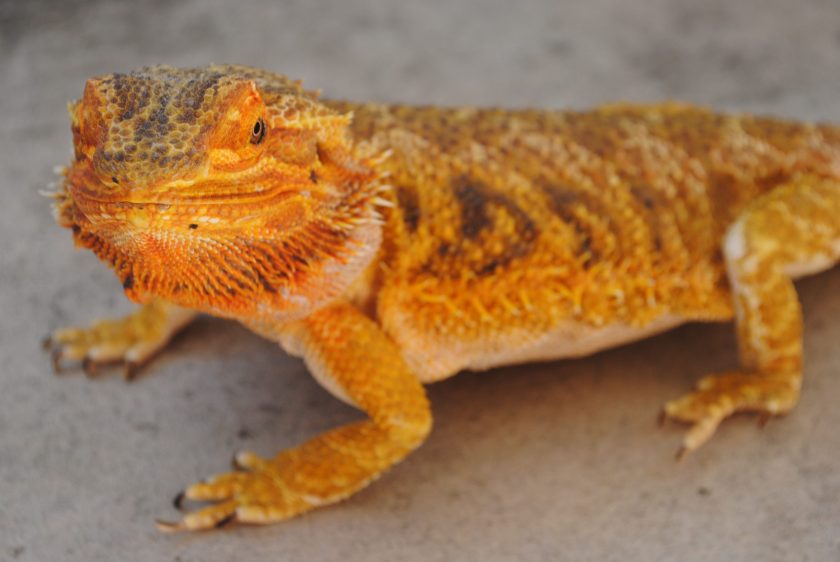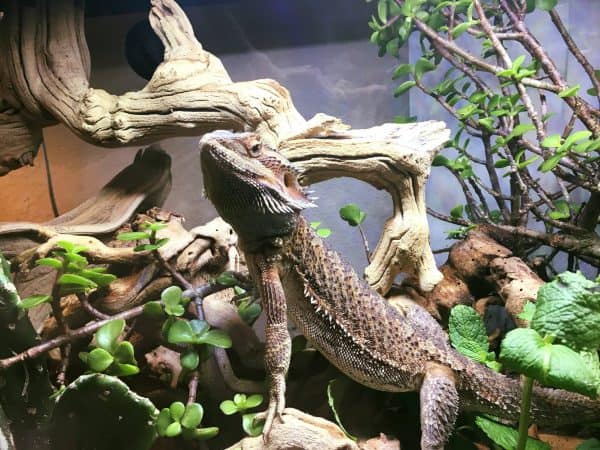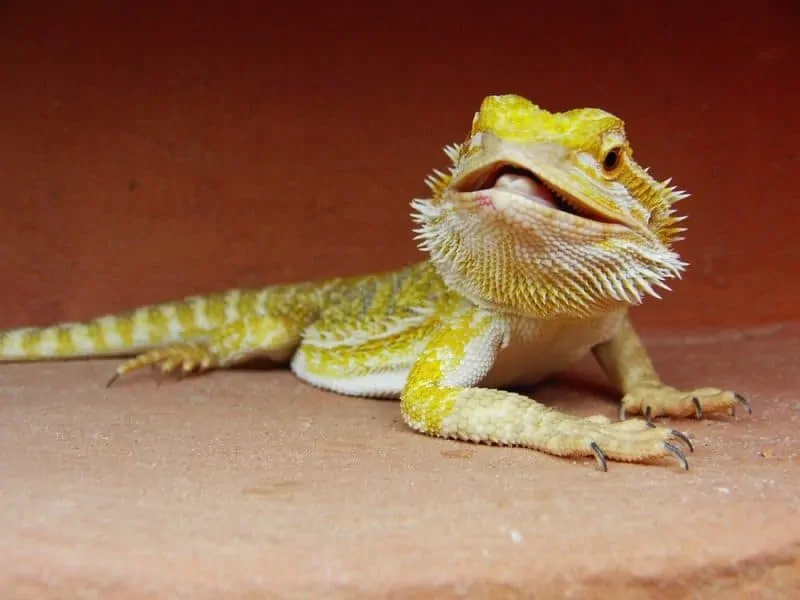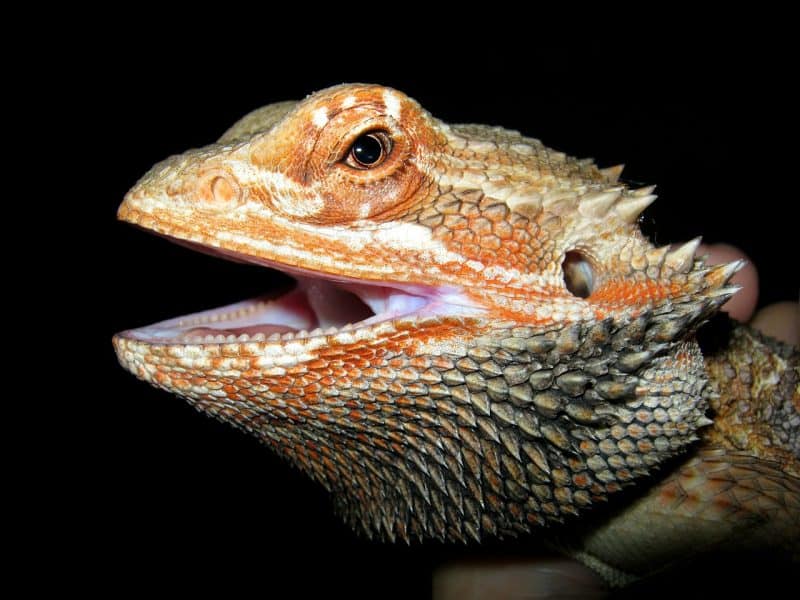When bearded dragons regurgitate, it is a sign that something is off in their husbandry. There are a variety of reasons why bearded dragons regurgitate; some are inconsequential while others can be life-threatening. The following are the main causes of regurgitation in this species:
Maintenance of the Bearded Dragon Enclosure
Most often, your pet’s regurgitating can be linked to its husbandry care. Careful consideration should be given to how your bearded dragon enclosure is being maintained and your feeding practices. In regard to the maintenance of the enclosure, you want to evaluate:
- Temperature & Humidity
- Water Access
- Enclosure Hygiene
- Substrate
Temperature
A common mistake that bearded dragon owners make is not setting up the proper temperature for their pets. Without the proper temperature, bearded dragons will either not eat or will not be able to digest their food properly. When the latter happens, they may regurgitate their food.
It is important to provide your bearded dragon with a temperature gradient, meaning that the enclosure should be set up so that the temperature varies in different parts of the enclosure.
The basking area should be the warmest part of the enclosure, and it should be kept between 92-110 degrees Fahrenheit. Also, it is important that you provide UVB lighting.
The coolest area of the enclosure should be kept between 75-85 degrees Fahrenheit. Creating this temperature gradient will allow your pet to find the temperature conditions that it needs to remain healthy.
It is recommended that the enclosure be equipped with two reliable thermometers so that the temperature can be monitored. There are also thermostats that you can purchase to help ensure the proper temperatures are maintained.
Humidity
Being desert creatures, bearded dragons should be kept at low humidity levels. If the humidity is too high, it can lead to respiratory problems and encourage the growth of fungi and bacteria. The humidity levels should be kept between 30 and 40 percent. Anything over 50 percent is too high.
As with the temperature, it is important that you maintain the humidity at the proper level. You can purchase a hygrometer to monitor the humidity in the enclosure. Also, it is very important to provide adequate ventilation in the enclosure. By doing this, you will help keep the humidity level down.
Water Access
Even though bearded dragons are desert animals, they need water daily in captivity. Without a daily supply of water, bearded dragons can become dehydrated. When they become dehydrated, they may regurgitate.
To prevent dehydration, provide the enclosure with a water dish and provide fresh water daily. Another option is to give your bearded dragon a bath 2-3 times a week. This can be done by letting your pet soak in a container containing shallow water.
Use warm water (around 80 degrees Fahrenheit) with a depth that reaches your pet’s shoulders, allowing them to soak for 15-20 minutes. It is important to watch your lizard when it is bathing to ensure that it does not drown or that it does not drink too much.
Just as it is important to keep your bearded dragon hydrated, it is also important to make sure that your pet is not over-hydrated.
When bearded dragons become over-hydrated, they will throw up water. The vomit of a bearded dragon that has consumed too much water will be clear and slimy. Their vomiting may be accompanied by a rocking motion, which is normal.
To prevent your bearded dragon from overdrinking, keep the water dish in the enclosure only two hours a day. You can also hydrate your pet by dripping water on its nose.
Enclosure Hygiene
If hygiene is not kept up in the enclosure, it can lead to the growth of bacteria, fungi, and parasites. All of these things can lead to disease or ill health. When a bearded dragon is not well, you guessed it, it may regurgitate.
It is recommended that you spot clean the enclosure daily and that you do deep cleaning monthly. When doing deep cleanings, everything should be removed from the enclosure and cleaned and sanitized.
To sanitize the enclosure, you can use a 9:1 solution of water to red vinegar. You can also use a veterinary-grade cleaner such as F10SC. When using commercial cleaners, make sure that you follow the instructions on the label.
If your bearded dragon is suffering health issues, you would be better off keeping the enclosure barren except for the hides and the water dish. You can use newspaper or paper towels as a substrate. By doing this, it will be easy to keep the enclosure clean.
Substrate
The use of the wrong kind of substrate in the enclosure can lead to potentially dangerous circumstances for your bearded dragon. The problem occurs when the loose substrate, such as sand, is swallowed by the lizard while it is feeding. The ingested substrate can create an impaction in the lizard’s digestive system.
When bearded dragons are impacted, they are unable to defecate, will stop eating, and they may regurgitate. If you suspect that your pet has an impaction, gently massage your lizard’s belly and let it soak in a warm bath. If neither of these methods work, bring your lizard to a veterinarian who is experienced with reptiles.
Are You Over Feeding Your Bearded Dragon?
Regurgitation can also be caused by incorrect feeding practices. Bearded dragons will become ill if they overeat. The problem is that well-intentioned pet owners will overfeed their pet because their pet continues to eat what it is given. As a result, they may regurgitate.
Regurgitation can also occur by overfeeding feeders like mealworms, which have hard shells. The hard shells can collect in the digestive system and create an impaction. Impactions can also occur from feeding your lizard oversized feeders.
As a guideline, do not feed feeders that are bigger than the space between your lizard’s eyes. If the vomit has undigested food particles in it, it may indicate that the impaction has been eliminated.
To avoid health issues when offering feeders, use the following guideline for frequency of feeding:
- Lizards up to 4 months old: Feed 2-3 meals per day.
- Juveniles (4-7 months old): Feed 2 meals per day.
- Adults (18 months and older): One meal a day.
Limit the number of insects to what your lizard can eat in 10-15 minutes. Also, You can keep a dish of fruit and vegetables in the enclosure.
> Further Reading: The Bearded Dragon Diet
Diseases of Bearded Dragons
The following are some diseases that can create vomiting in your bearded dragon:
Salmonellosis
Salmonellosis is a gastrointestinal disease and is caused by salmonella, a bacteria. The salmonella bacteria is found naturally in the digestive system of animals; however, improper husbandry can result in the bacteria multiplying. It is this increase that creates health problems for the animal.
Symptoms of salmonella include vomiting and diarrhea. Additionally, salmonella is considered to be a zoonotic disease, which means that it can spread to humans. It is for this reason that it is important to wash your hands well after handling your pet.
Also, it is worth noting that if your bearded dragon is vomiting, it is unlikely due to salmonella. The reason for these issues with the enclosure’s maintenance or feeding practices is far more prevalent than salmonella infections.
Coccidia
Coccidia is a type of parasite that is commonly found in kittens and puppies; however, bearded dragons have been known to contract it. This parasite is found in the intestines, and symptoms of coccidia include bouts of regurgitation, anemia, and retarded growth.
As with salmonella, coccidian is normally found within bearded dragons. They become a problem when their populations grow due to inadequate husbandry. When detected early, coccidian is easily treated by a veterinarian, who can prescribe medication.
Signs of Possible Parasitic Infection
Parasites, including salmonella and coccidian, deprive their host (the animal inflicted by them) of the nutrients from the food that they eat. The result is that the lizard’s health declines. The following are possible symptoms that your bearded dragon has parasites:
- A lack of appetite
- Lethargy
- Weight loss
- Diarrhea
- Vomiting
- Irritability
If you suspect parasites, it is important to have your bearded dragon seen by a veterinarian who is familiar with treating reptiles. When bringing your lizard to the vet, bring along samples of your pet’s vomit and fecal matter. Your vet will be able to test these samples to determine if your lizard has parasites.
> Further Reading: The Bearded Dragon Health
What Vomit Can Tell You
By inspecting the vomit, you may be able to gain some clues to what is happening with your bearded dragon.
Throwing Up Blood
Vomit-containing blood may indicate an enlarged liver. This condition can be caused by the lizard being overweight due to overfeeding. Other possibilities include cancer. If you see blood in the vomit, get your pet to a veterinarian immediately.
If you did not witness your bearded dragon regurgitate, it is important to not jump to conclusions. It is important to distinguish bloody vomit from bloody stools. Reddish stools may be the result of feeding your pet berries.
One way to distinguish bloody vomit from bloody stools is to look at how it is deposited. When bearded dragons vomit, it is normally flung around the enclosure due to the lizard shaking its head. In the case of stools, they will be deposited in a neat pile.
Throwing Up Mucus
If there is mucus in the vomit, it may be a sign of an upper respiratory infection (URI). URIs are caused by humidity levels that are too high. Other signs of URI’s include mucus coming out from the lizard’s mouth or nostrils. If you suspect a URI, bring your pet to a veterinarian as soon as possible as URIs can be fatal.
Another possible cause for mucus in the vomit is that the lizard drank water that went bad. By changing your pet’s water daily, you will avoid this problem. However, bad water is not only caused by improper husbandry. Some locales have high levels of chemicals, such as fluoride, in their water. If your locality is like this, consider giving your pet distilled water instead.
Caring for Weakened Bearded Dragons
If your bearded dragon is vomiting, it is recommended that you bring it to a veterinarian. In the meantime, there are things that you can do to help your pet out. If your lizard is vomiting repeatedly, it is having difficulty keeping its food down.
If your pet is not keeping its food down, then it is not getting the proper nutrients. If this is the case, then your lizard will not have the needed nutrients to stay healthy and keep up its weight.
As an intervention, you can feed your bearded dragon baby food. Baby food is good for these situations because it will be gentle on your pet’s stomach. Besides being easy to digest, baby food can also act as a laxative.
If your lizard is impacted, the baby food may help your pet have a bowel movement. Try feeding them either sweet potato, butternut squash, or pumpkin. You can also try organic apple sauce that does not contain added sugar.
You can serve these foods to them using a spoon. If they refuse to eat, you can force feed them using a syringe. Another trick is to add a few drops of vegetable oil to their food. This can also help them have a bowel movement.
Husbandry and Crime Scenes
If your bearded dragon is vomiting, you should review your husbandry practices in detail. Treat it as a crime scene. Determine if the temperature and humidity levels are correct. Is your lizard dehydrated? Check to see if you are overfeeding your bearded dragon.
If all these factors meet with best practices for husbandry, and your pet is still vomiting, it is time to get it to a veterinarian. When you go, make sure that you bring a sample of their vomit and fecal matter. Bag them up and put them in your refrigerator to keep them fresh.
FAQ
Is it normal for my bearded dragon to throw up?
No, it is not. If your bearded dragon regurgitates, it is most likely that there is a problem in the husbandry care it is receiving.
Did my bearded dragon eat something it should not have?
It is possible that it swallowed a foreign object, such as a substrate, or that it consumed a food item that was too large. Overfeeding can also be a cause.
What to do after the bearded dragon throws up?
Monitor your pet and verify that it is receiving the proper husbandry care. If it continues to regurgitate, have your pet seen by a veterinarian who is familiar with reptiles.
As bearded dragon owners, I believe we have a responsibility to give them the best care possible. If your pet is regurgitating, it is important to re-evaluate your husbandry methods to determine what changes are needed. We hope you found this article useful and welcome your comments and questions.





